Bob and I started down the InterCoastal Waterway (ICW) from Wynne Maryland for the first time in November 2000.
 |
| Our boat at the dock in the Marina |
Some people go in groups headed by a person who has done the ICW before. We just headed out on our own. My 90 year old mother moaned that I was deserting her. My daughter confided to her friend that she thought her parents were going to hit a reef and drown when their boat sank. We had a ‘float plan’ which is the boat equivalent of a flight plan. Each evening I would check in by phone with my son, and tell him where we expected to be the next night. If he didn’t hear from us, he could notify the Coast Guard where to look for us.
The trip from Maryland to Miami took 51 days. I kept a journal or log on the trip of our adventures, and I emailed these journals to my mother whenever I could. Each day, I would write down on a pad of paper what we saw and did. Each evening, I would write up an email.
In those days, the internet was not as ubiquitous as it is now. I had two options for doing email. I could connect the computer up to a phone line and get my email that way. Or I could use a service called Pocket Mail which was a device with an acoustic modem which I used with a phone. I had a bag phone (one of the first mobile phones) which I could attach to the antenna at the top of the mast and I got really good range with that. I also had one of those early cell phones.
Although I felt really prepared for the trip – I had done extensive research and had gone to seminars. I had the charts and maps and guidebooks. But each morning I felt just slightly nauseated. I told someone later it was like morning sickness, except I knew I wasn’t pregnant. It was not until after I read a book by Lynn Pardee where diagnosed her seasickness as anxiety that I realized that was what it was. I didn’t have any problem on the second trip – only on the first one.
Here are some excerpts from the logs.
November 1, 2000
 |
| SV RosalieAnn under sail |
We sailed out of the Potomac on a good wind, but as we came around Smith Point out in the Chesapeake the wind died. We spend the night anchored in Mill Creek off the Great Wicomico farther up than the first time past the G5. The night in Mill Creek was very quiet. There was another sailboat across the way this morning, but no other activity at all
 |
| Anchorage in Mill Creek |
November 2, 2000
We have breakfast and pull the anchor about 8, and motor out of the creek and into the Chesapeake. It is a nice day with hardly any wind. We try to sail at least once, but don’t manage well at all. The wind is directly behind the boat, and there is too much risk of accidental gybing and we don’t have a whisker pole. We’ve decided to go down south of Stingray point and go into Deltaville to anchor for tonight.
We’ve been into Deltaville twice. This time, since we don’t need to worry about pump out, we anchored in Fishing Bay behind Stove Point Neck around on the Piankatank. This is a popular anchorage, with room for a lot of boats without them having to be too close together and has good protection from the north, east and west. When we arrived about 1 pm (and were anchored at 37.32.185’N /076.20.041’W by about 2 pm), we had done 25 nautical miles at an average speed of 5.3 knots.
There were already 3 boats in the anchorage – a boat with red topsides (the part of the boat above the water), a boat from the UK and a ketch. They were all on the west side where all the marinas and yards are – we anchored on the east. Other boats came in and anchored in front and behind us, but there was plenty of room. We had a completely peaceful night here.
November 3, 2000
We weren’t sure we could get all the way to Hampton Roads the next day, so we decided to stop in Chisman Creek. We pulled the anchor and left pretty early (only had a bagel for breakfast instead of eggs as usual). We motored out and down the Chesapeake without even trying to put up the sails this time. When we went in, we could not find a number of the marks, and when we left the next morning the CG boat was replacing some of them.
After we passed Wolf Trap light south of the Piankatank (and you can see I am still using a film camera – I have a digital camera but haven’t used it much yet)
 |
| Wolf Trap |
and saw New Point Comfort Light way off on the end of Mobjack Bay, we crossed the York River and went into the Poquoson River. The Poquoson River branches off the York River. Our guide book (“A Gunkholer’s Guide Cruising the Chesapeake” by William Shellengerger) says, “The Posuoson River itself has little to attract the cruiser, quickly becoming shoal before there is much in the way of protection.” But it recommends Chisman Creek which curves north after you round the red 14 marker south of York Point. It says there are 3 marinas there, none of which offer transient facilities.
We can see some tall red and white smokestacks of the Amaco refinery (or a power plant) as we crossed the York River. They are a landmark for entering Chisman Creek which otherwise doesn’t have many marks. Chisman Creek is on the starboard as you pass the R10. We anchored just inside York Point.
This day we did 32.6 nautical miles at an average speed of 5.6 knots, and anchored about 1400.
 |
| Smokestacks on the York River |
The green line on the chart shows our track to the anchorage. The drawing of Chisman Creek on the left is from Chesapeake Bay Magazine’s Guide to Cruising the Chesapeake Bay.
As we anchored a work boat putting out crab pots came up behind us and circled the boat, putting one pot directly in front and one directly behind the boat. Although the crab pot boat is almost within arms reach of us, no eye contact was made.
We spent a completely quiet night. Most of the traffic in this area is work boats and small power boats the wakes from which rocked the boat as we were not anchored very far out of the channel. The minimal traffic ceased around dark.
November 4, 2000 – Happy Birthday to me
It was flat calm all night last night and very quiet. We had eggs and bacon for breakfast and then started the engine and Bob started to pull the anchor and try to figure out how to get out without running into the crab pots.
There is a boat coming into the creek towing in another boat, and I hear him on the VHF talking to the boat he is towing. I also hear some conversations which I think are between lock tenders and sailboats on Ch 13. We leave between 0800-0830. There is hardly any wind as we run down the coast. There are other sailboats out there including a couple of catamarans with sails up, but they must be motor sailing.
I did the routing for today after Bob was asleep and when we had the cabin hatch boards in. The charts were in the cockpit and I didn’t want to wake Bob up when I went to get them. I think I took us too far out into the Bay. After we get underway, I try to reconstruct the route on the computer to go closer to shore, but it is really difficult with just the little eraser end type pointer and without a mouse (I have a trackball, but the connector is too long to fit into the computer box in the cockpit.). We decide to go inside the Thimble Shoal light. We start seeing more big ship traffic.
 |
| Chamberlain Hotel (which is now an old folks home) |
As we come down into Hampton Roads, we can see the Chamberlain Hotel from a long ways off. Old Point Comfort Marina, and everything else in this area except the Chamberlain Hotel was at that time part of the Fort Monroe Army Post. We come down alongside Fort Monroe and we can see the brick row houses – military housing and the Old Point Comfort Lighthouse.
As we round the hotel coming in toward the marina about 12:15 , I call on the cell phone and tell them we want fuel before we go into our slip. The fuel dock is on our starboard as we enter, and we want to tie up port side to the dock. However, due to the wind, the boat is only backing to starboard instead of to port as it usually does, and we end up coming in on the starboard side. We use their lines, since all ours are rigged on the other side.
We get 15 gallons, and Bob goes up to pay. We tell them we are supposed to go into slip B33. They say there is no way we will fit in a slip on B dock (which is mostly small power boats). The guy who seems to be in charge runs up to the office and says it was supposed to be E 33, but he is going to put us into E38 instead. That’s really better as that way we don’t have to go around between the docks to the other side but just go in as we come around the protective wall. I think he decides this based on how incompetent we were at getting in to the fuel dock but whatever the reason, it’s better for us..
One of the fuel dock guys and a guy from one of the other boats help us to tie up. The docks are floating docks and transient rates are $1/foot. There is free water, and free electricity, but only 50 amp outlets, so we rent a splitter for $5. (a splitter divides the output from 50 amp into two 25 amp sections)
Our trip today has been 22 nm at an average speed of 5.5 knots.
In 2000, the marina was open to anyone who wanted to come, but by 2003, the marina only allowed civilian transients if they are DOD employees (military, Coast Guard or civilian employees), or work at Fort Monroe. Since Fort Monroe has been decommissioned, the marina is open to everyone again.
The people tied on the end of E dock next to us are Fred and Sharon in an aft cockpit Gulfstar named DOLPHIN . Fred is a retired submariner from New London CT This is their first trip down the ICW too and they are bound for Ft. Pierce.. Bob fusses around with the lines until he has us tied as he wants.
Right outside the marina is a big protected anchorage between the entrance to the tunnel and Old Point Comfort. You just have to be careful not to anchor in the channel especially of the commercial fishing boats in the far corner. We go up to the hotel for lunch, but it is too late and they are not serving lunch.
 |
| Fishing boats in the far corner |
I go back to the boat and find my chicken from Wendys (from the 31st) and eat that and make myself a cheese sandwich. Bob goes out to the commissary, which Sharon warns him will be closing, and to the PX and brings back sandwiches, but we get into conversation with Fred and Sharon, and don’t eat them. (As of 2003 the commissary is closed.)
 |
| Zero Mile Post of the Chesapeake and Ohio RR – next to the commissary |
Then we go up to the hotel to try to use the phone to connect to the internet and have dinner. The phones there will require a phone cable to connect, and that is in my other computer bag.
I have a nice birthday dinner – it is a buffet but the dishes are not labeled. The soup, the waitress tells us is vegetable beef. NOT. There is no beef in this soup -I know there is crab in it. It is a spicy tomato base, but I don’t see any vegetables. The head waiter guy says it is really a crab/lobster bisque. Also on the buffet is some kind of a chicken dish in cream sauce with big hard biscuits in it, a beef dish, rice, potatoes, broccoli, green beans, rolls (but not hot) and a salad bar. After dinner we walked back to the boat (I picked up my email with pocketmail), and had an early night.
November 5, 2000
It rained last night. I heard an annoying loud dripping sound over my head (don’t know why – it isn’t leaking inside), and then I could also hear the pitter patter of the rain The wind has picked up quite a bit too. Since it is from the north, and the boat is in the slip pointed south, this makes a loud slapping noise when the waves hit the stern. Normally, this is not a problem at anchor because the boat would usually ride bow to the waves.
The rain stops before morning. Fred and Sharon from Dolphin intend to go to the brunch buffet at the hotel this morning. We were told that it didn’t start until 11:00 am, so Bob takes the laundry and goes up to do that and have a shower. I piddle around on the boat. It is both windy and cold. The furling sail on the boat opposite us looks like it will be torn off the furler.
We leave to walk up to the hotel about 10:45. We get there at about 11:10, and find the brunch doesn’t start until 11:30. Fred and Sharon are hungry, as they haven’t eaten since last night about 6:30 but I had a couple of bagels this morning, so I’m fine. I suggest that they go out on the steps overlooking the pool, and I go into the visitor’s center and use Pocketmail.
When we go into the hotel again there is a long line waiting to get into the dinning room. However, they take us without a reservation, and seat us in the front row where we can look out the windows at an angle (we are beside the wall, but there’s a window at a 45 deg angle from the table at each side).
The “world famous seafood brunch” is $18.50 each, and includes champagne, juices, coffee, and a buffet where there is (on this day), egg drop soup, omelets to order, ham, roast beef, salmon, waffles made fresh (the ones with the big deep holes) with syrup and preserves, tossed salad, scrambled eggs, bacon, sausage, diced fried potatoes, half baked tomatoes, steamed shrimp, Alaskan king crab legs, mussels, meat loaf, a stuffed crab shaped thing, rolls, apple pie, strawberry moose and coconut cake. At least that’s what I remember of the offerings. Bob and I had cranberry juice. Bob and Fred and I wanted hot tea, but they could only find 2 tea bags, so Bob and I shared. It took us two hours to eat from start to finish.
Then we went up to the 8th floor to look out over the fort and Hampton Roads. It is a beautiful view up there. We could see the marina,
 |
| Marina from the top of the hotel |
and the fort ramparts
 |
| fort ramparts |
 |
| Commercial ship coming by Fort Wool |
And Fort Wool across the way. The land that Fort Wool was built on was started by ships dumping their ballast there.
 |
| Photo of the fort from the air |
The hotel is the tallest building around, and a well known landmark. The wait staff was setting up for a wedding reception in the terrace room so we left and walked over to the fort. The hotel went out of business after 9-11 because anyone who wanted to go there to eat or use the hotel had to submit to a search. It is now an old folks home
 |
| Piers from the top of the hotel |
We walked along the waterfront, past the place where the old Baltimore ferry dock used to be (that Bob used to travel on with his family to visit their relatives in Norfolk), past the Old Point Comfort Lighthouse
 |
| Old Point Comfort |
 |
| Old Point Comfort which is almost dwarfed by the fort ramparts, |
which is almost dwarfed by the fort ramparts past the Engineer’s pier (which they built to bring in the materials to built the fort), and went into the fort through the East gate.
This gate (and also the North gate) is just wide enough for one car (oversized vehicles have to use the Main Sallyport on the west), so there are traffic lights at either side.
 |
| Sally Port |
One comes while I am on the bridge over the 8 foot wide moat and have to stand out of the way for a car to enter the fort, and then again when I am in the middle of the tunnel through the fort walls when a car is coming out, so I duck into a pedestrian cavity to allow them to come through. Bob and Fred and Sharon are a bit ahead of me because they walk faster and don’t stop to take pictures.
 |
| Quarters on Ft Monroe |
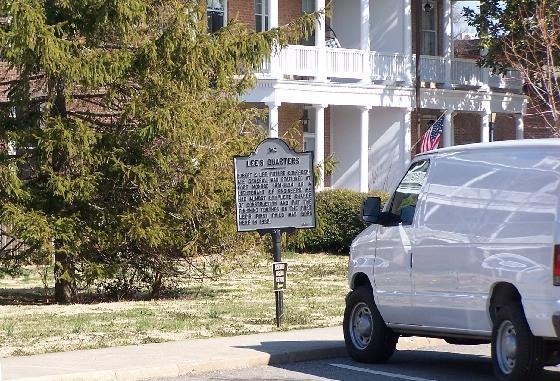 |
| Quarters One sign |
Quarters One is right opposite the East Gate. It is the oldest residence on the post, and Lincoln and the Marquise de Lafayette have both stayed there. We walk around inside the fort, where Army families are still quartered, past the house where Robert E. Lee stayed in 1831-1834 when he was stationed here and was stabilizing the island where Fort Wool is located (it was then Fort Calhoun).
 |
| Drawing of the fort from 1862 |
We pass Jefferson Davis Memorial Park above us on the rampart
 |
| Jefferson Davis Memorial Park |
and the Flagstaff Bastion,
 |
| Ramparts |
 |
| Ramparts |
and then we enter the Casement Museum.
 |
| Cannons in front of the Casement Musuem |
The (free) Casement Museum is in the fort casements which is what they call the rooms inside the fort walls.
 |
| Information on Edgar Allan Poe’s brief time at Fort Monroe |
They have several dioramas set up, including one of firing the cannons,
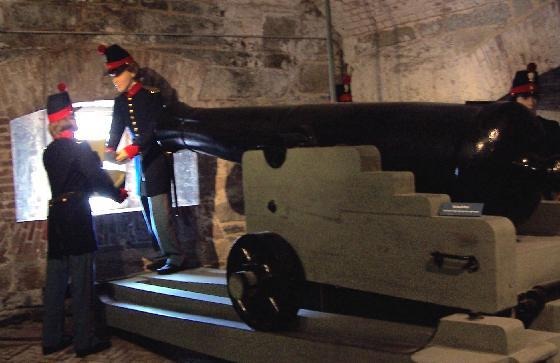 |
| Firing the Cannon |
one of the cell where ex-Confederate President Davis was held for several months,
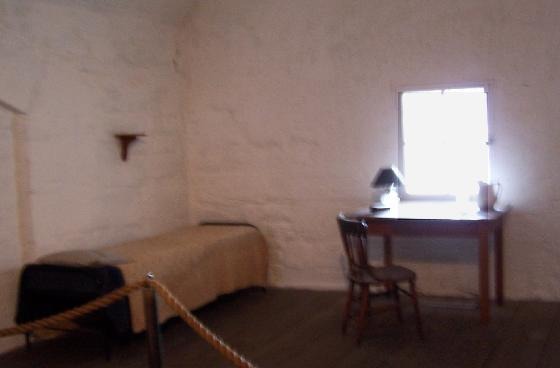 |
| Cell where ex-Confederate President Davis was held for several months |
one of the Casement Club which was apparently an early officer’s club,
 |
| Casement Club |
and one of a quarters for an army family with a piano, and a bed – an officer would get 2 rooms.
 |
| Officer’s Bedroom |
 |
| Officer’s Living Room |
The casements are no longer used for quarters, but the chaplin has his offices there, and the post day care is also housed. in the casements. We saw a short interesting video tape presentation on the Ghosts of Ft. Monroe, and saw a little show with narration and flashing lights on a map of the Chesapeake about the armament and the ranges of various types of artillery,
 |
| Lighted map demonstrating the range of guns |
but the little 30’s movie of the firing of the disappearing gun was broken, and we didn’t get to see that. We cic gdt to see it on a subsequent visit
 |
| Disappearing gun |
There were plenty of places to sit in the museum even without sitting on Jefferson Davis’s chair (which is in a glass case anyway).
 |
| Jefferson Davis’s Chair |
There were plenty of places to sit in the museum even without sitting on Jefferson Davis’s chair (which is in a glass case anyway).
We exited the museum after peeking into the gift shop, and walked back up toward the old cistern
 |
| Old Cistern |
which was appropriately marked as a confined space, and exited by the postern gate.
 |
| Approaching the Postern Gate |
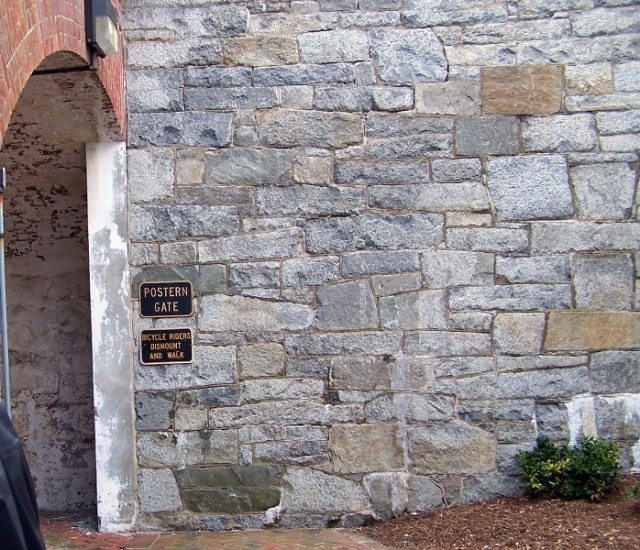 |
| Postern Gate |
There was a sign advising bike riders to dismount, which would certainly be necessary as one of the passages had an arch which was only about 5.5 feet tall at the center. As Fred said – a bike rider would boink himself on the head.
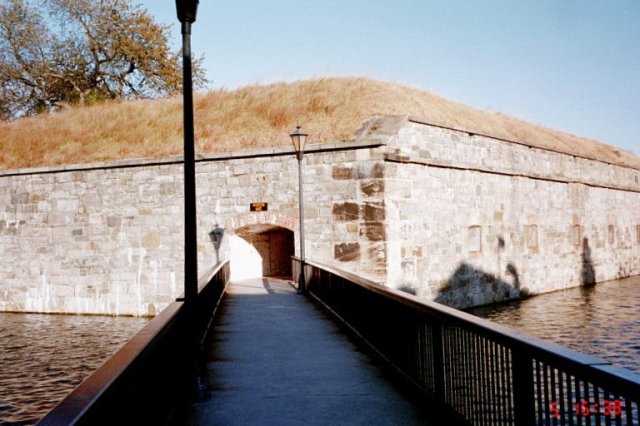 |
| Looking back on the Postern Gate from the moat bridge |
We walked back to the marina, and stopped off to see what the weather on the weather channel said. Bob and Fred decided to stay another day. Bob said with the wind the way it is, we probably couldn’t get out of the slip. We visited with them on their boat for a bit. We still have block ice, so Bob bought some more cubes. I watched the football game on TV and Bob started the electric heater up and read yesterday’s paper (forgot to get today’s paper). The NOAA weather say the wind is 20-25 knots, and in some places in NC is gusting to 31 knots. Went to bed early.
November 6, 2000
This was to be a lazy day. I wanted to cut Bob’s hair, but didn’t get it done. He wanted to repair the UV protecting Sunbrella (the dark stripe) on the jib.
 |
| Bob repairing a sail at home you need a big space |
It was too windy to do that as the jib would have to be taken down. Instead, he got out his tools and started modifying the cockpit locker that contains the pass-through into the kitchen (which originally had a caddy with glasses- we took the caddy out) so that it has a tray in the top to store things like winch handles
 |
| Original locker configuration |
and I worked on writing up the sections of our trip. Bob wanted to walk up to the hotel for lunch. The people in the marina are afraid that letting me attach the computer to their phone system will mess it up so he was impatiently waiting for me to get done with what I was writing so we could have lunch and this time I would bring a phone cord to attach the computer.
There was a soup and salad bar, and the specials were meat loaf or crab cake sandwich. I should have taken one of them, but I had a cheese steak sub, and Bob had a BLT. Both very good, and pretty cheap, and we watched the harbor out of the window while we ate.
Then we tried to hook up the computer to the internet. It took a long time and a lot of futzing around before I got the computer hooked up and I had to use an #800 number because the phones in the hotel wouldn’t accept a local number with an area code and area codes for the area have recently been added and are required. Then packed up and walked back to the boat. The whole thing with lunch and all took from 12:30 to 3:30. And lunch didn’t take that long.
We went back to the hotel for dinner, and I had what they described as a “rib eye with bone” steak. (It was really a Tbone.) I took some of it home in a doggy box. We again watched the ships, and we amused ourselves by listing all the equipment we’d bought for the boat.
Back at the boat, I set the nav program to statute miles instead of nautical miles because that is the way the ICW is measured. Bob (grumbling) switched the antennas on the radios so that the one that will send is on the tall antenna.





